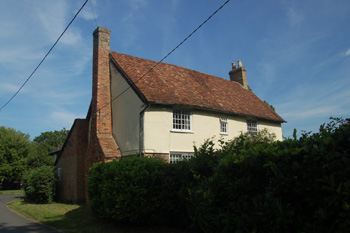The Three Horseshoes Public House Colmworth

The former Three Horseshoes August 2009
The Three Horseshoes Public House [also The Horse Shoe and The Old Horse Shoe]: King's Cross or Queen's Road, Colmworth
This public house has been referred to in a number of different ways but is first noted as the Three Horseshoes in 1791 when Isaac Field sold it to John and William Foster of Biggleswade, merchants. At some point it became known as the Horseshoe before once again becoming the Three Horseshoes in 1824. By 1876 the owner was Thomas Millard or Miller who, in his will of that year, devised it to his wife Sarah for her life, to be sold after her death. The public house was part of a farm called, not surprisingly, Horseshoes Farm.
By 1901 Ernest Millard was tenant of the Three Horseshoes and owed over a hundred pounds to brewers and leaseholders Day & Son of St.Neots. To assist his son, Thomas Millard (perhaps son of Thomas and Sarah) agreed to underwrite the debt by mortgaging his furniture and other property such as livestock in and around the public house. The public house itself was sold by auction by Edward L. Welsted in 1918, although Bedfordshire & Luton Archives & Records Service does not possess the conveyance to him from the Millard family he is shown as owner in the licensing registers of about 1901 and so presumably purchased the premises on the sale that would have occurred on the death of Sarah Millard. The public house closed in 1920 after no application to renew the licence was received.
The Rating and Valuation Act 1925 specified that every piece of land and building in the country was to be assessed to determine its rateable value. The valuer visiting the former public house [DV1/H22/56] found that it was still part of a farm of a hundred acres, now owned and occupied by William Bailey. The house comprised two reception rooms, a kitchen, scullery, dairy, pantry and cellar with four bedrooms and a boxroom on the first floor. A wood barn and privy stood outside. Water came from a pump with "good power".
The homestead comprised the following buildings: a henhouse; a stable for three horses and chaff bay; a three bay open hovel; two stables for two horses each; two calf boxes; a corn and chaff barn and an implement barn. To the right of these buildings stood another henhouse. The buildings were mostly constructed of brick and tile with some built of wood and thatch.
The former public house was listed by English Heritage in August 1983 as Grade II, of special interest. The building dates from the 18th century, as the date of the first known landlord indicates. It is timber-framed with red brick on the ground floor and north gable end and rendered on the first floor. The house has an old clay tile roof.
References:
- WG1497: covenant to levy a fine on large farm house now called Three Horseshoes from Isaac Field of Lilley [Hertfordshire] to John and William Foster of Biggleswade, merchants: 1791;
- CLP13: Register of Alehouse Recognizances [Horseshoe 1822-1823; Three Horseshoes 1824-1828]: 1822-1828;
- WG1472: copy will of Thomas Millard alias Miller of Eltisley [Cambridgeshire] devising all real estate to trustees for his wife Sarah for her life, then for sale: 1876;
- WG1473: bill of sale from Ernest Millard of Three Horseshoes and Thomas Millard to Frank Day of St.Neots [Huntingdonshire], brewer with inventory "to be sold in distraint for rent and goods sold": 1901;
- PSS3/1: Register of Alehouse Licences - Sharnbrook Petty Sessional Division: c.1901;
- WG1474-1475: assignment of legacy by Thomas Millard and Hepzibah, his wife, to Frank Day: 1902;
- PSS3/2: Register of Alehouse Licences - Sharnbrook Petty Sessional Division: c.1903;
- PSS3/3: Register of Alehouse Licences - Sharnbrook Petty Sessional Division: 1904-1930;
- WG2618: sale catalogue of various properties including Three Horseshoes: 1918
List of Licensees: note that this is not a complete list. Italics indicate licensees whose beginning and/or end dates are not known:
1791: Richard Stringer;
1822: John Haynes;
1828-1885: John King (also wheelwright and Post Office 1862-1885);
1890: George Ward;
1894-1898: Richard King;
1901-1903: Thomas Ernest Millard;
1903-1913: William Parrin;
1913-1920: Spencer Peet
Public House closed 1920